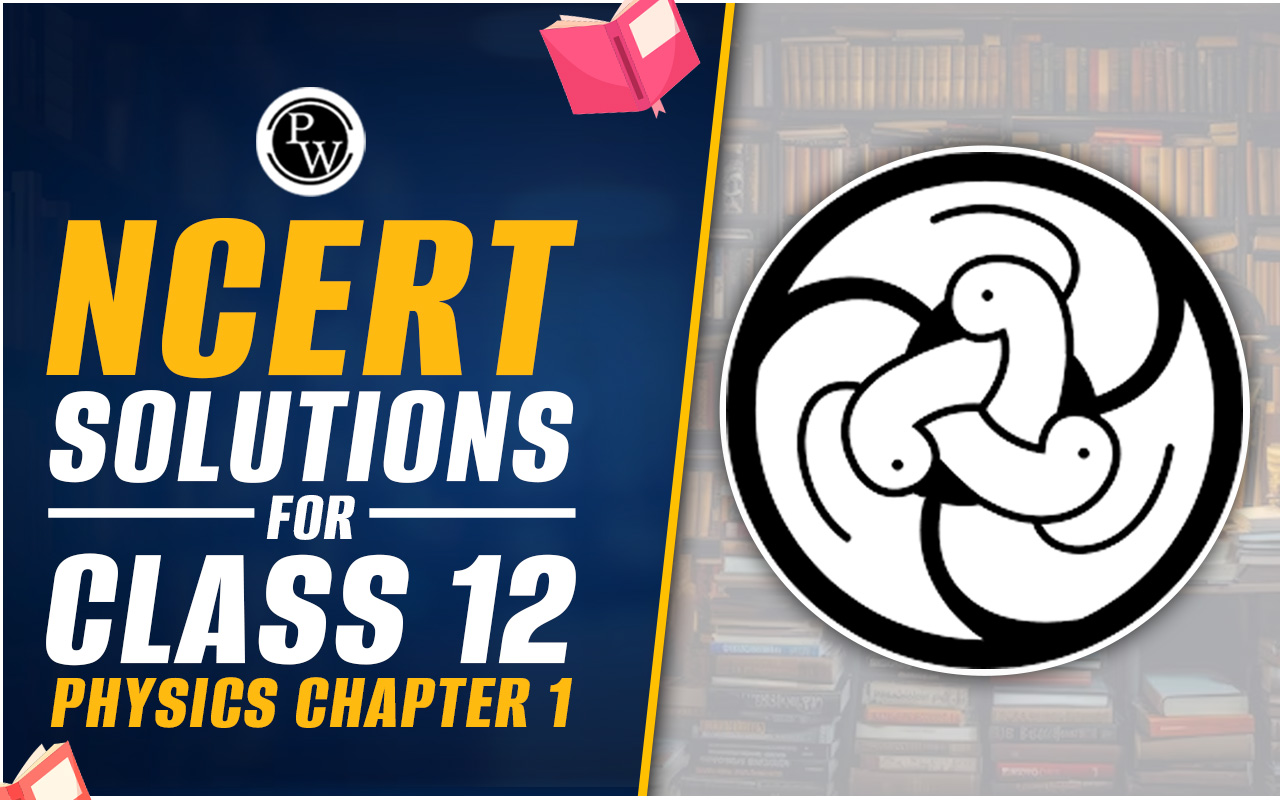
CBSE Class 11 Biology Notes Chapter 8: In Chapter 8 of CBSE Class 11 Biology, you'll learn about cells, which are like tiny building blocks of life. These notes help you understand what cells are and how they work.
There are different types of cells, like those with a nucleus (eukaryotic) and those without (prokaryotic). The notes also explain the parts of a cell, like the outer layer called the plasma membrane, the jelly-like substance inside called cytoplasm, and the control center called the nucleus. By studying these notes, you'll get a better idea of how cells function and why they are so important in biology.CBSE Class 11 Biology Notes Chapter 8 Cell the Unit of Life Overview
Chapter 8 of CBSE Class 11 Biology, "Cell: The Unit of Life," provides an in-depth understanding of the cell as the fundamental structural and functional unit of life. It covers the cell theory, emphasizing that all living organisms are composed of cells. The chapter details cell types: prokaryotic (simpler, without a defined nucleus) and eukaryotic (complex, with membrane-bound organelles and a true nucleus). It also explores cell organelles like the mitochondria, chloroplasts, endoplasmic reticulum, and Golgi apparatus, each with specific functions crucial to cellular processes. Understanding cell structure and function helps explain the organization and functioning of all living beings. Using our CBSE Class 11 Biology Notes Chapter 8 will make review extremely simple, fast, and convenient. For this reason, our has provided all of these topics in the CBSE Class 11 Biology Notes Chapter 8 in a free PDF download format. To view the CBSE Class 11 Biology Notes Chapter 8 at anytime, anywhere, without requiring an internet connection, simply download it once to your device.CBSE Class 11 Biology Notes Chapter 8 Cell the Unit of Life PDF
CBSE Class 11 Biology Notes Chapter 8 Cell the Unit of Life
Discovery of Cell
The discovery of the cell was made possible by the development of the microscope. In 1665, scientist Robert Hooke improved the compound microscope and examined a piece of cork under it. He observed tiny structures that looked like chambers and named them "cells." Soon after, Antonie van Leeuwenhoek, a Dutch scientist, discovered even smaller organisms like bacteria and protozoa using a simple microscope he had perfected. Leeuwenhoek's microscope had just one lens but could magnify objects up to two to three hundred times their original size. These discoveries opened up a whole new world of microscopic exploration.Cell Theory
The cell theory, a cornerstone of biology, comprises three fundamental principles. The first part, formulated by Theodor Schwann in 1839, posits that organisms consist of cells. Building on this, Schwann and Matthias Schleiden, after studying plant and animal cells, proposed the second part, which states that cells serve as the fundamental structural and organizational units of all organisms. Rudolf Virchow contributed the third part in 1858, asserting that cells arise from pre-existing cells. Together, these principles form the basis of our understanding of cellular biology and the organization of living organisms.Overview of Cell
Cells are broadly classified into two categories: Prokaryotic and Eukaryotic. Prokaryotes include unicellular organisms from the kingdoms Bacteria and Archaea, while eukaryotes encompass animal cells, plant cells, fungi, and protists. Despite their differences, all cells share four common components: a plasma membrane, which acts as an outer covering separating the cell's interior from its environment; cytoplasm, a jelly-like region within the cell where various cellular components are located; DNA, the genetic material responsible for cell function and heredity; and ribosomes, particles essential for synthesizing proteins. However, eukaryotes and prokaryotes differ in several aspects, including the complexity of their internal structures and the presence or absence of a nucleus.Prokaryotic Cell
A prokaryotic cell is a type of single-celled organism lacking a true nucleus or membrane-bound organelles. Organisms within the Bacteria and Archaea domains are based on this type of cell. Prokaryotic cells are enclosed by a cell membrane, which provides protection and helps maintain their shape and moisture levels. They contain free-floating DNA and ribosomes, although these ribosomes are not attached to the membrane.Eukaryotic Cell
Eukaryotic cell is characterized by having a clearly defined nucleus enclosed within a nuclear membrane. This nucleus contains chromosomes. Eukaryotic cells also possess various organelles such as mitochondria, Golgi apparatus, endoplasmic reticulum, and lysosomes, which perform specific functions. Eukaryotic cells are generally larger and more complex compared to prokaryotic cells found in bacterial and archaeal domains.Difference Between Prokaryotic Cell and Eukaryotic Cell
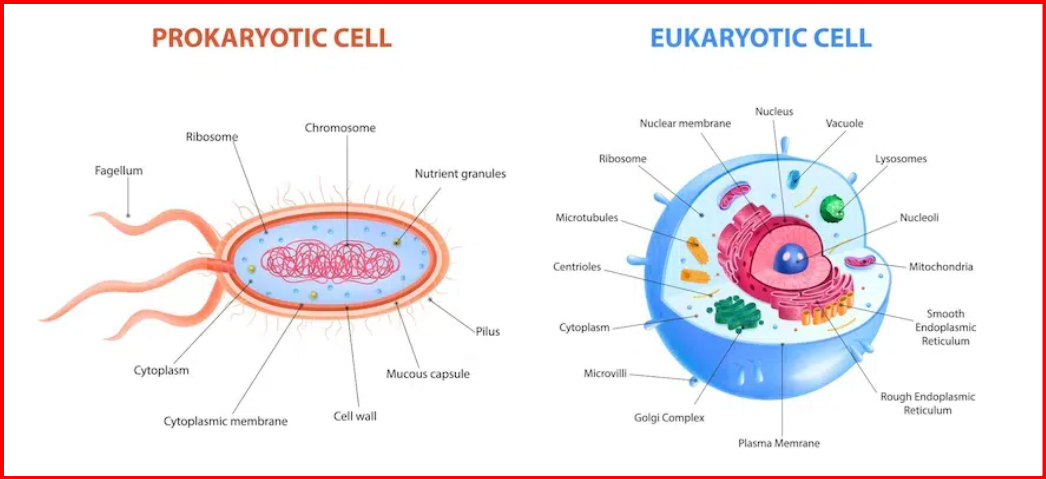
Cell Structure and Function
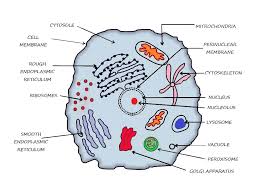
Cell Membrane (Plasma Membrane): The cell membrane acts as a barrier, separating the internal environment of the cell from the external environment. It regulates the passage of substances in and out of the cell, ensuring that essential molecules are taken in while waste products are expelled.
Cell Wall (in plant cells): The cell wall provides structural support and protection for plant cells. It helps maintain cell shape and prevents the cell from bursting when internal pressure increases. Additionally, the cell wall allows for the exchange of water, nutrients, and gases between adjacent cells.
Cytoplasm: The cytoplasm is the gel-like substance that fills the interior of the cell. It houses various organelles and cellular structures, providing a medium for chemical reactions to occur. The cytoplasm also serves as a site for the movement of organelles and other cellular components.
Nucleus: The nucleus houses the cell's genetic material, DNA, and controls the cell's activities by regulating gene expression. It is surrounded by a double membrane called the nuclear envelope, which separates the nucleus from the cytoplasm. Within the nucleus, the DNA is organized into structures called chromosomes.
Organelles: Organelles are specialized structures within the cell that perform specific functions. Examples include:
- Mitochondria: Responsible for generating energy in the form of ATP through cellular respiration.
- Endoplasmic Reticulum (ER): Involved in protein synthesis and lipid metabolism. Rough ER has ribosomes attached to its surface, while smooth ER does not.
- Golgi Apparatus: Modifies, sorts, and packages proteins and lipids for transport within or outside the cell.
- Lysosomes: Contain enzymes that break down waste materials and cellular debris.
- Chloroplasts (in plant cells): Site of photosynthesis, where light energy is converted into chemical energy in the form of glucose.
Fluid Mosaic Model
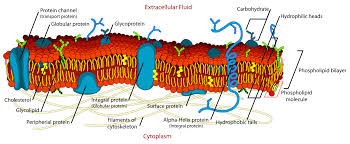 The Fluid Mosaic Model, proposed by Singer and Nicolson in 1972, describes the structure of the cell membrane as a dynamic and fluid arrangement. In this model, lipids form a bilayer with proteins embedded within it, resembling a mosaic pattern. The fluid nature of the lipid molecules allows proteins to move laterally across the membrane, contributing to its flexibility and adaptability.
The Fluid Mosaic Model, proposed by Singer and Nicolson in 1972, describes the structure of the cell membrane as a dynamic and fluid arrangement. In this model, lipids form a bilayer with proteins embedded within it, resembling a mosaic pattern. The fluid nature of the lipid molecules allows proteins to move laterally across the membrane, contributing to its flexibility and adaptability.
Functions of Cell Membrane
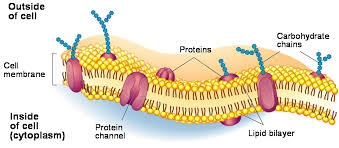 The cell membrane, composed of 52% proteins and 40% lipids, serves several crucial functions:
The cell membrane, composed of 52% proteins and 40% lipids, serves several crucial functions:
Physical barrier: It separates the internal environment of the cell from the external environment, providing protection to cellular components and allowing different activities to occur independently inside and outside the cell.
Structural support: The membrane supports the cell's structure by protecting the cytoskeleton, a network of protein fibers that maintains the cell's shape and integrity.
Selective permeability: The membrane regulates the passage of molecules in and out of the cell, allowing essential substances like water, oxygen, and carbon dioxide to pass through while controlling the movement of ions and other polar molecules.
Endocytosis and exocytosis: The membrane facilitates the processes of endocytosis, where the cell engulfs large molecules or particles from the extracellular fluid, and exocytosis, where it releases substances into the extracellular space.
Cell signaling: Specialized proteins and carbohydrates on the membrane's surface play a crucial role in cell signaling and communication, allowing cells to respond to external signals and interact with one another.
What is Cell Wall?
Cell walls are rigid structures that form the outermost layer of the plasma membrane in fungi and plants, providing support, structure, and protection to the cells. While most plant cells, fungi, bacteria, algae, and some archaea possess cell walls, animal cells do not. The structure of cell walls varies among organisms. In plants, the cell wall primarily consists of strong cellulose fibers, glucose, and polymers, while bacterial cell walls are composed of sugars and peptidoglycan. Fungal cell walls contain chitin, glucans, and proteins. Plant cell walls are divided into three layers:Middle lamella: Contains polysaccharides called pectins, facilitating cell adhesion between neighboring cells.
Primary cell wall: Found in developing plant cells, consisting of hemicellulose fibers and pectin polysaccharides embedded in a matrix of cellulose microfibrils.
Secondary cell wall: Present in some plant cells, reinforced with lignin in addition to cellulose and hemicellulose, providing strength and water-conducting capabilities to vascular tissues.
The functions of cell walls include:Support: Providing structural support and mechanical strength to cells, regulating cell growth, and facilitating cell division.
Control cell growth: Signaling the cell cycle to initiate cell division and expansion.
Control diffusion: Regulating the passage of molecules into and out of the cell.
Communication: Facilitating communication between plant cells through channels called plasmodesmata.
Defense: Acting as a barrier against pathogens and preventing water loss.
Storage: Storing carbohydrates for energy usage during plant growth and development, particularly in seeds.
Endomembrane System
 The endoplasmic reticulum (ER), Golgi complex, lysosomes, and vacuoles collectively form the endomembrane system within cells.
The endoplasmic reticulum (ER), Golgi complex, lysosomes, and vacuoles collectively form the endomembrane system within cells.
Endoplasmic Reticulum (ER): The endoplasmic reticulum is a network of tubular structures dispersed throughout the cytoplasm. It exists in two forms: rough ER (RER), which has ribosomes on its surface, and smooth ER (SER), which lacks ribosomes. RER is involved in protein synthesis and secretion, while SER plays a role in lipid synthesis and detoxification.
Golgi Apparatus: The Golgi apparatus is responsible for processing and packaging proteins and lipids, particularly those intended for export from the cell. It consists of flattened sacs called cisternae, which are stacked parallel to each other. The Golgi apparatus synthesizes glycoproteins and glycolipids and sorts and packages molecules into vesicles for transport.
Lysosomes: Lysosomes are membrane-bound vesicles containing hydrolytic enzymes produced by the Golgi apparatus. They function as the cell's "garbage disposal," breaking down unwanted molecules, such as lipids, proteins, carbohydrates, and nucleic acids, into smaller components that can be recycled or disposed of.
Vacuoles: Vacuoles are membrane-bound organelles found in the cytoplasm of cells. They contain various substances, including water, sap, and excretory materials. In plant cells, the central vacuole can occupy up to 90% of the cell's volume and is involved in storing water, maintaining turgor pressure, and storing ions, metabolites, and waste products. In other organisms like amoebas, vacuoles play roles in excretion, osmoregulation, and digestion.
Here are the functions of each component of the endomembrane system:
Endoplasmic Reticulum (ER):
Rough ER (RER):
- Synthesizes proteins destined for secretion or insertion into membranes.
- Provides a large surface area for protein synthesis due to the presence of ribosomes.
Smooth ER (SER):
- Synthesizes lipids, including phospholipids and steroids.
- Detoxifies harmful substances by enzymatic reactions.
- Stores and regulates calcium ions, which are important for signaling and muscle contraction.
Golgi Apparatus:
- Receives proteins and lipids from the ER and modifies them by adding carbohydrates (glycosylation), phosphates, or sulfates.
- Sorts and packages modified molecules into vesicles for transport to their final destinations, such as other organelles, the cell membrane, or secretion outside the cell.
Lysosomes:
- Contain hydrolytic enzymes capable of breaking down macromolecules, such as proteins, lipids, carbohydrates, and nucleic acids, into smaller components.
- Digest worn-out organelles, foreign particles, and engulfed pathogens through a process called autophagy or phagocytosis.
- Participate in programmed cell death (apoptosis) by degrading cellular components.
Vacuoles:
- Store water, ions, nutrients, and waste products, helping maintain cell turgor pressure and osmotic balance.
- Aid in the digestion of macromolecules through the hydrolytic enzymes present in certain types of vacuoles, such as lytic vacuoles in plant cells.
Vesicles:
- Transport molecules between organelles within the cell or to and from the cell membrane.
- Mediate the exchange of proteins, lipids, and other substances required for cellular processes, including secretion, endocytosis, and intracellular trafficking.
Mitochondria
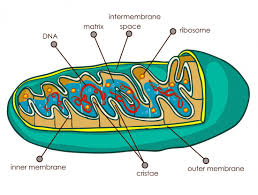 Mitochondria referred to as the cell's powerhouse, play a pivotal role in energy production within the cell. Structurally, mitochondria are cylindrical or sausage-shaped organelles, typically measuring 1.0–4.1 m in length and 0.2–1.0 m in diameter. They consist of a double-membrane structure, with an outer membrane and an inner membrane that divide the organelle into two compartments: the outer compartment and the inner compartment. The inner compartment contains a dense material called the matrix, while the inner membrane forms invaginations called cristae.
The functions of mitochondria are multifaceted and include:
Mitochondria referred to as the cell's powerhouse, play a pivotal role in energy production within the cell. Structurally, mitochondria are cylindrical or sausage-shaped organelles, typically measuring 1.0–4.1 m in length and 0.2–1.0 m in diameter. They consist of a double-membrane structure, with an outer membrane and an inner membrane that divide the organelle into two compartments: the outer compartment and the inner compartment. The inner compartment contains a dense material called the matrix, while the inner membrane forms invaginations called cristae.
The functions of mitochondria are multifaceted and include:
Aerobic Respiration: Mitochondria are the primary sites for aerobic respiration, the process by which cells generate energy in the form of ATP (adenosine triphosphate) from oxygen and nutrients.
ATP Production: Through a series of biochemical reactions occurring in the inner mitochondrial membrane, mitochondria produce ATP, which serves as the primary energy currency of the cell.
Genetic Material: Mitochondria contain their own genetic material in the form of a single circular DNA molecule, as well as RNA molecules, ribosomes, and other components necessary for protein synthesis. This unique feature suggests that mitochondria have their own semi-autonomous genetic machinery.
Apoptosis: Mitochondria play a crucial role in programmed cell death, or apoptosis, by releasing specific proteins and enzymes that initiate and regulate this process. This mechanism helps maintain cellular homeostasis and eliminate damaged or unwanted cells.
Detoxification: In liver cells, mitochondria contribute to the detoxification of ammonia, a toxic byproduct of metabolism, by converting it into less harmful substances.
Plastids
Plastids are double-membrane bound organelles found in plant cells and euglenoids. They possess their own DNA and ribosomes. Plastids play crucial roles in various cellular processes and can be classified into three main types based on the pigments they contain:
Chloroplasts : These are double membrane-bound organelles similar to mitochondria. Chloroplasts contain chlorophyll and carotenoids, which capture light energy required for photosynthesis. They consist of a stroma surrounded by thylakoids, organized into grana. Chloroplasts are responsible for photosynthesis in plant cells.
Chromoplasts : Chromoplasts contain pigments such as carotene and xanthophylls, giving plant parts yellow, orange, or red colors. They are involved in the synthesis and storage of pigments, contributing to the coloration of fruits, flowers, and other plant structures.
Leucoplasts : Leucoplasts are colorless plastids that serve various storage functions. They can be further categorized into different types based on their contents:
- Amyloplasts : Store carbohydrates, particularly starch, in plant cells, such as in potatoes.
- Elaioplasts : Store oils and fats.
- Aleuroplasts : Store proteins, particularly in seeds.
Ribosomes
Ribosomes are cellular structures where protein synthesis occurs. They are composed of RNA and proteins and can be found either free in the cytoplasm or attached to the endoplasmic reticulum. Eukaryotic ribosomes are larger (80S) than bacterial ribosomes (70S) and consist of two subunits: a large subunit (60S) and a small subunit (40S). Ribosomes play a vital role in translating genetic information from mRNA into proteins, essential for various cellular processes and functions.Cytoskeleton
The cytoskeleton is a complex network of protein filaments present in the cytoplasm of eukaryotic cells. It consists of three main types of filaments: microtubules, intermediate filaments, and microfilaments. The cytoskeleton provides structural support, facilitates cell movement and shape maintenance, and is involved in intracellular transport and cell division.Cilia and Flagella
Cilia and flagella are hair-like extensions of the cell membrane that facilitate cell movement. Cilia are short, numerous, and involved in moving fluid surrounding the cell, while flagella are longer and fewer in number, responsible for cell propulsion. Both cilia and flagella possess a 9+2 microtubule arrangement, consisting of a central pair surrounded by nine doublets.Centrosome and Centrioles
The centrosome is an organelle containing two centrioles, which play a crucial role in organizing microtubules during cell division. Centrioles are cylindrical structures composed of nine triplets of microtubules arranged in a cartwheel-like pattern. They serve as the base for the formation of spindle fibers during cell division.Nucleus
 The nucleus is a membrane-bound organelle that houses the cell's genetic material and regulates gene expression. It consists of the nuclear membrane, nucleoplasm, chromosomes, and nucleolus. The nucleus plays essential roles in genetic regulation, protein synthesis, and cell division, contributing to the overall functioning and integrity of the cell.
The nucleus is a membrane-bound organelle that houses the cell's genetic material and regulates gene expression. It consists of the nuclear membrane, nucleoplasm, chromosomes, and nucleolus. The nucleus plays essential roles in genetic regulation, protein synthesis, and cell division, contributing to the overall functioning and integrity of the cell.
Structure Of Nucleus
The nucleus is a membrane-bound organelle found in eukaryotic cells, housing the cell's genetic material and regulating gene expression. It consists of several components:Nuclear Membrane : Also known as the nuclear envelope, it is a double-layered membrane that surrounds the nucleus, separating its contents from the cytoplasm. The outer membrane is continuous with the endoplasmic reticulum, while nuclear pores perforate the membrane, allowing the selective exchange of materials between the nucleus and cytoplasm.
Nucleoplasm : The nucleoplasm is the gel-like substance present inside the nucleus, similar to the cytoplasm in composition. It contains water, ions, enzymes, and various dissolved molecules, providing a medium for cellular activities within the nucleus.
Chromosomes : Chromosomes are thread-like structures composed of DNA molecules complexed with proteins called histones. They carry genetic information in the form of genes and are responsible for determining an organism's hereditary traits. During cell division, chromosomes condense to form distinct structures visible under a microscope.
Nucleolus : The nucleolus is a prominent structure found within the nucleus, typically one or more per nucleus. It is involved in the synthesis and assembly of ribosomal RNA (rRNA) and ribosomal subunits, essential for protein synthesis. The nucleolus appears as a dense region devoid of a membrane, containing DNA, RNA, and proteins.
CBSE Class 11 Biology Notes Chapter 8 FAQs
How are prokaryotic and eukaryotic cells different from each other?
Explain the structure and functions of mitochondria.
Describe the structure of the nucleus.
Discuss the structure and functions of ribosomes.
What is the cytoskeleton, and what functions does it serve?

